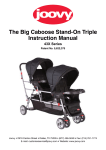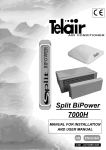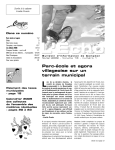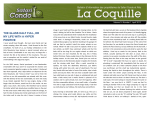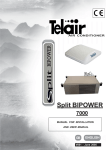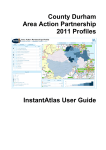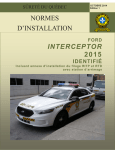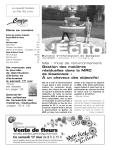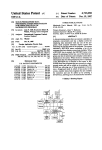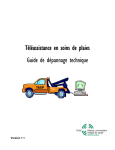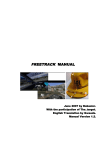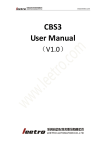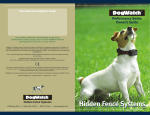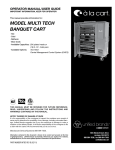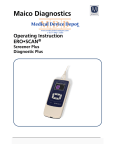Download 10 Weeks in an Alto
Transcript
10 Weeks in an Alto Retirement was close at hand. Marie-Paule and I explored all options. A Class A? Too big, too energy-consuming. Maybe a C, but preferably a Class B. The roof must be rigid and the vehicle must enable us to occasionally live through a cold night. And since we intended to travel up to six months at a time, we wanted a cost-efficient vehicle. We looked at Roadtrek or perhaps a Class C when, watching "Adventure en VR" on Evasion channel, we saw Paul Laquerre in his Alto. It was a love at first sight (not for Paul! For the Alto...). At the next VR Show, we went to see the Alto, came to a decision, and signed the contract on the spot. We chose almost all possible options that would facilitate life aboard the trailer over several months. About six or seven months later, we took delivery of our Alto. Our salesman, Gilles, took Safari Condo staff somewhat short by accepting our request to take up the trailer on the day following his phone call, because we had to go through Saint Nicholas anyway. The whole team made an extraordinary effort to get the work done, all the while teasing Gilles for his actions. By the way, I have never seen Gilles since … Maybe that it was not only teasing after all! We left towing our new home behind us. The next Fall, we had time to test the Alto a few times before the first snow, to prepare the long trip coming in January, come retirement. I noticed that the propane heater used a lot from the 20lbs propane tank. We would have to avoid staying more than two nights in very cold weather without a refill. I must admit I did, due to inexperience, put on a bit too much heat the first times out. In fact, simply leave the thermostat at the minimum to prevent freezing and wear warm night clothes. The "Travasak" available at Safari Condo is exceptionally comfortable and well adapted to the Alto. With these first Fall experiments behind us, we left Quebec on January 25 2010 on a "nowhere" to southern United States to any location where we would find warm weather, excluding Florida which is too busy and expensive at this time of year. We left in the cold, but without too much snow on the ground, and raced south of the border to avoid storms, the worst in decades. The first night, we slept with the roof down to save on heating. In this configuration, the Alto is still liveable, accessible inside in spite of reduced space, with even a toilet if necessary. But the trailer was still winterized. We used antifreeze for the toilet. Since our journey is on the Condists’ forum. I won’t go into details here. We criss-crossed the South, from Alabama to the southern tip of Texas close to McAllen, then returned through northern Florida, Georgia and other Atlantic States, stopping two days in New York, to enjoy the beautiful warm days prior to Easter. Our most beautiful stop was the National Big Bend Park in West Texas. For four days, we were in self-sufficient mode. Both solar panels were used to charge the battery and we never ran out of power. Indeed, this is the kind of camping we plan to do next year. Our great discovery was the "boon docking" we practiced in Wal-Mart parking or "travel centers" when we travelled between two targeted destinations. Enough to say that we've traveled almost 10 weeks in our Alto, pulled by a V6 Rav4! We had several cool days followed by cold nights. We have always been comfortable in the Alto. With my new talent for propane management, I have only filled up the bottle twice in this trip, coming home with even a little bit of propane left. On occasion I worried about the fuel consumption on the Rav4 trip computer. Surprise! Our travels cost us approximately 15 ¢ per kilometre, with all trips, even locally, sometimes without the trailer. Given frequent face winds and travelling speeds, no surprise, but not as we had hoped. We travelled a total of 12 200 km. We are delighted with our Alto. Once, I thought we had water infiltration through the 130W solar panels connectors. False alarm: during torrential rain on the beautiful white sand of the Gulf of Mexico, condensation rolled on the roof, accumulated behind a neon sign and drained to the ground. While plugged into 30 amps, I occasionally used the heat pump to keep warm. Once I used it in cooling mode to reduce condensation inside when it rained all day. Unfortunately, the States have had their coldest winter in trailerite’s memory and we did not need air conditioning except this one time. Marie-Paule complains that the sink, though elegant, does not drain completely. Speaking for myself, I believe that I should have installed the 3.8 litre electrical heater rather than the 23 litre propane heater. This water heater requires a lot of propane to do its job. Finally, I almost never use it: an electric kettle gives us enough hot water at a time to do the dishes and meet our needs for a quick wash-up in the evening. If we want to use the shower, which we did only twice in those 10 weeks, I heat up the whole 23 litres, although not at the max. And before anyone comments on this subject, I would add that we did use showers in comfort stations if they were well maintained! Furthermore, other Altoïsts operate their electric heater on their dc-ac inverter. Which reminds me that I did not see dc-ac inverter on the options list? So I assumed that the solar power integrated conversion system would also operate the microwave. It was not the case, as I have discovered in the Fall in our first tests. I had it installed for this long journey. We used it occasionally to operate the microwave we can’t do without, especially in places like the Big Bend Park without services. Solar panels have kept the battery on par for this trip. We must admit that Marie-Paule and I closely monitored our use of resources. Never more lights than necessary. TV (HD please) turned off when finished listening to CDs or DVDs. Here is another disadvantage, according to Marie-Paule: now that I have tried HD in our trailer, I need one at home! Do you want my old TV? It is on the LesPAC and nobody wants it... There is still much to say; for lack of space here, we’ll talk about it on the forum. We have learned much on this trip by exchanging with others who like Paul Laquerre travel in their Alto or otherwise. We now know that our project for longer trips, up to six months at a time, is possible in our Alto. We have returned without the usual fatigue from a trip in hotel rooms or worse yet, under the tent. It was very nice to feel "at home" even when parked overnight in the Wal-Mart parking lot in New Jersey, or in Liberty Harbor RV Park in New York, before the statue of liberty. What a great way to travel! We are already preparing our next trip, traveling in Quebec during the summer, and exploring warmer latitudes during the winter. For a description of the places we visited, go to the Condists’ forum! Or even request an article on this aspect of our trip for the next Coquille! Denis Marcoux and his wife Marie-Paule Côté DMX on the Condists’ Forum Great Get-Together 2010 In Compton On September 24-26. 2010 This year, the invitation to the Great Get-Together comes from our friends at VR design, Sylvain Veilleux and Alain Rabi. Co-owners in this VR sales and repair business, our two friends have also been Safari Condo product distributors in the Estrie region for years. Sylvain is originally from the charming village of Compton and well-known to Mr. Aimé Mélix, owner of the Camping de Compton and our host for the weekend. Camping de Compton, winner of numerous tourism awards, is nestled alongside the village, allowing you to walk or cycle to different restaurants, grocery stores or the Louis. S. St-Laurent Museum. We chose the September 24 to 26 weekend partly because in Compton village, it is Comptonales time. On this special day, you will discover local “terroir” products and meet local farmers and learn their secrets. Indeed, they invite you in their home so you may enjoy the fruit of their labour, and share their passion with you. End of September, also means apples, bicycle strolls through colourful surroundings and “one last time” get-togethers before the cold season settles in. Over the weekend, we will meet for dinner Saturday evening as well as attend our Annual Seminar with Daniel and our special guest, Mr. Paul Laquerre. Mr. Laquerre is editor-in-Chief of “Camping Caravaning” magazine and has over 40 years VR experience, will entertain you on "travelling to the United States without losing your shirt". He will generously share with you his backpacking tips. Don’t miss this opportunity! Arrival is scheduled for 1:00 p.m. on Friday September 24 2010. If you arrive a few days early to stay a little longer in the area, expect to be moved around when the group arrives. As usual, we will share sites to accommodate the greatest number of Condists. Everyone will have access to electricity, but always by sharing. As in years past, if you want to be with friends, you must arrive together to the campground, or once installed on your site, notify your friends by telephone of the location where you are. It is too complicated for volunteers to remember everyone's friends in order to match them. We have done it for many years, but for the Great Get-Together to continue, we must keep things simple and not to overwork our volunteers. The price for additional camping days if you arrive before or stretch your stay is the same rate as during the get-together, or $ 20 per day. A windfall! The designated sites and the room reserved for the dinner will accommodate a maximum of 200 vehicles. Fill out the attached registration form and send it along with your payment to the specified address no later than July 15, 2010. As the Comptonales attracts many tourists and M. Mélix has set aside a section of its campground, cancellation will be not be possible. Hope to see you to at the Get-Together in Estrie and have a good summer! Michèle Here are some useful addresses: Camping Compton 24, chemin de la Station, Compton (Québec) J0B 1L0 Local calls: 835-5277 819 Toll-free line: 1 800 563-5277 E-mail: [email protected] Web site: www.campingcompton.com The Comptonales http://www.comptonales.com/fr/accueil/index.shtml Daniel’s Corner AWNINGS AND SCREEN SHELTERS Michèle and I are currently in Florida for our traditional April holiday. A month of sunshine, cycling and have nothing else to do but choose the evening menu. We made the trip in our brand new Sprinter XL Plus. This will be a good opportunity to tame this new environment and study its behaviour on the road as well as its fuel consumption. You know how this is important to me. By introducing a new Safari Condo chassis family, I must rethink some accessories that were available on the GM chassis. The Screen Shelter that can be attached to the vehicle is one of those accessories. Before reinventing the wheel, I wanted to profit from the work that others have done before me, so I've ordered a screen shelter which attaches directly to the Sprinter’s Fiamma awning, designed specifically for it by the same manufacturer. Here's a summary of the different Screen Shelters available, their uses, pros and cons. AWNING Usefulness: Shields off the sun, rain and expands your territory. Have the impression of sitting on our patio and not eating next to a car. As it unfolds in minutes, if the wind is not too severe, you can use it almost anytime. Note that when much travelling is involved, the awning is little used. On a trip to the western US, Michèle and I visited all day and returned completely bushed to our campsite. We just had time to grab a dinner, half-asleep over our plate. In 30 days, only once did we set-up the awning. When to use: AWNING’S ENEMIES Wind: Each year, we repair many awnings damaged by wind. Since the awning can be dismantled very quickly, it should be put away when you leave the vehicle, especially when thunderstorms are anticipated. This can save you much hassle and money (several hundred dollars). The awning must always be fixed to the ground using provided stakes. Ropes at the two corners can be added for more strength. However, even when perfectly installed, winds can still tear your awning. The awning is useful when you are there, and should always be closed if you are not around your vehicle. Water problems are always due to a lack of inclination. In addition to an inclination towards the front, give your awning a tilt to the left or right by lowering one of the legs (not valid for the Alto). Water damage can be impressive. In addition to the canvas, the aluminum structure will break under the weight of a huge water pocket. If the slope is not large enough to allow a smooth water flow, a pocket will form in the canvas. This type of damage will occur while you sleep, or while you're gone for a walk. Rain: SCREEN SHELTERS: There are 3 kinds of screen shelters: a conventional cooking shelter, one adapted by Safari Condo to attach to your vehicle, and one for your awning. Only the first two are compatible with the Alto. Screen Shelter (cooking shelter) Completely independent of your vehicle, it remains on-site if you leave with the vehicle. Keep things inside. Available in a wide variety of models, sizes and colors; with or without screen flaps. Note that the flaps are strongly recommended. Usefulness: Leave your site with your vehicle without having to disassemble the shelter. Shields off mainly mosquitoes and, if equipped with flaps, also sun and rain. With a set-up time of approximately 15 minutes *, set it up for a minimum of a week end, or if there is a dinner among friends and mosquitoes are a pest. When to Use: Disadvantages: Having to zip and unzip door whenever is one goes between the vehicle and the screen shelter. Each round trip increases chance of mosquito intrusions. Not for use in strong winds. Modified Screen Shelter, Attached to Vehicle This product, made from a screen shelter with added flaps, this adaptation by Safari Condo for a GM chassis based Safari Condo or an Alto. Easily detachable from vehicle, it remains on site if you have to drive away. It allows you to keep things inside. Usefulness: In the case of Safari Condo, leave your site with your vehicle without having to disassemble shelter. Protection from mosquitoes and light winds, even sun and rain with the flaps down. As it is attached to the vehicle, take advantage of your heating system inside the shelter when the side door is open. An auxiliary heater can also easily be installed. Enjoy a legendary lobster dinner, even under a cold rain on the coast of Maine. Record number for a dinner with Michèle and Daniel: 16. No need for heating! As the shelter becomes a vehicle extension, no need to open and close the door whenever we want to get something from the vehicle. When to use: With a set-up time of approximately 20 minutes *, set it up for a minimum of a week end, or if there is a dinner among friends and mosquitoes are a pest. Disadvantages: More expensive. Not for use in strong winds. It takes a little longer to set-up than the conventional screen shelter. Awning’s Screen Shelter At this time, we are using on our Sprinter the Fiamma Screen Shelter, which attaches to the Fiamma awning. Before developing a product for the Sprinter, we wanted to try out the Fiamma Screen Shelter specific to the Sprinter. Usefulness: Protection from mosquitoes and light winds, even sun and rain with the flaps down. As it is attached to the vehicle, take advantage of your heating system inside the shelter when the side door is open. An auxiliary heater can also easily be installed. When to use: With a set-up time of approximately 40 minutes *, set it up for a minimum of a week end, or if there is a dinner among friends and mosquitoes are a pest. Disadvantages: Very expensive. Smaller than the cooking shelter that we adapt. When I received my screen shelter, I found out that the rain flap to install between the wheels under the vehicle to protect from mosquitoes was optional! During set-up, I had to block multiple openings, including that part which extends along the vehicle between the awning and roof. The purpose of course was to mosquito-proof as well as water-proof. Perhaps they don’t have mosquitoes in Italy? I must say that I am disappointed with this product because of this. The rain flap ought to be included to the asking price, and more attention ought to be to make this really mosquito-proof. The initial set-up is long and complex. Once complete, hope you don’t need to leave with the vehicle in the next half hour. You should have seen Michèle’ face when I told her that we should take it apart and set-up again; in order to give you a better overview of actual set-up time, we sent you a picture of the finished product. In summary, if the awning is very simple and quick to set-up, all screen shelters require set-up time and storage in the vehicle. Identify our needs and the kind of trips you plan. * This set-up time is one of two people who have already done it a few times and who know how to go about it. LAST MINUTE NEWS FROM DANIEL: SPRINTER XL PLUS FUEL CONSUMPTION Michèle and I are left for Florida March 29 at the end of the day, the day following the end of the Salon du VR de Québec. Between Vallée-Jonction and Sanibel Island, we encountered no bottlenecks, had no problem and the road was dry all the way. Our XL Plus performed as expected and led us safely and comfortably to our destination. You can imagine how much I look forward to compiling the fuel consumption with this new vehicle. I already had my data on the LX series Sprinter used last summer, but this trip was the first with the 22 ' Mercedes chassis. To date, our average is 25.4 miles per gallon or 11.1 L / 100 km. It's fairly easy to get 25 miles per gallon at an average of 100 to 109 km/h. At 100 km/h, we made 10.3 L / 100 km or 27.7 miles per gallon! Which is great for a vehicle of this size? Fuel consumption for my trip to Florida will be available on the internet on the Condists’ Corner on my return. Daniel In the Workshop, with Fred Here are a few Spring tips to switch your vehicle to camper mode. Please note, however, that all these recommendations are in your owner's manual: do not hesitate to use it whenever an issue arises. BATTERY MAINTENANCE For all Vehicles Manufactured Before the 2009 Model Year These vehicles were equipped with batteries which require maintenance. You must verify or have someone check the level of liquid in the batteries. Ideally, this maintenance should be performed twice a year. If done by a professional, he can also test the battery capacity. If you do it yourself, never use tap water, but distilled or demineralised water. Also, check the battery connections for corrosion. In that case, disconnect and replace old connectors with new. If you have to unplug connections to replace your battery or replace terminals, get a good diagram in order to be able to successfully reconnect your batteries. Several Condists blew their dc-ac converter (Hein Denis!) by making bad connections. Once you check, don't forget to reseal the cover and battery box. This prevents hydrogen emissions in the vehicle when the batteries are charging. Ideally use Dap’s Seal ‘N Peel as a sealer, or Flextra. Never use silicone. If your batteries are located under the vehicle, refer to your vehicle’s manual on how to access. For All 2009 and Newer Models If your vehicle is a 2009 and newer model, batteries located inside are maintenance free. They are sealed and you should never open them. If they are opened, they will need to be replaced. PLUMBING DEWINTERIZING After you have filled your tank with water, and you detect a small water leak, the culprit is probably the filter located between the water tank and pump. For reasons still unknown, small cracks form on the plastic filter during the winter, even in vehicles that were perfectly well winterized. If you go for long holidays just after dewinterizing your vehicle, it is important to make a good check to ensure that there is not the slightest leak. It is easiest to fix the problem before leaving than on the road. If the filter is the culprit, you can drop in at the factory, or we can simply send one through the mail. On the road, in an emergency, you can simply remove the filter and, plug the tank pipe, if long enough, directly to the pump. Bear in mind that the dewinterizing procedure is explained in the vehicle manual. IMPORTANT: Make sure that the water heater is full before plugging the electric water heater or turning on the propane heater. In the case of the propane heater, power pump to ON and through the vehicle’s outer grid, open the safety valve to check water flow. If water does not flow or air escapes, there is no water in the boiler and the dewinterizing was not done properly. See manual in dewinterizing section, where we talk about bypass valves. Prior to filling your water heater, we recommend that you replace the sacrificial anode located at the bottom of the heater. Access is by the vehicle’s outer grid. Replacement should take place at least once every two years or every year if you know that your water is hard. SEALS: Over the years and by the action of the sun, joints ensuring watertight integrity between the roof and attached devices become dry and can crack. It is good to check the fan joint, solar panels mounts and the joint along the canvas, or in the case of electric roof, between the electric roof and the top of the vehicle. If you discover a cracked or detached joint, and you want to do the repairs yourself, remove the faulty part, clean the surface well with thinner or methyl alcohol and replace the faulty seal with Flextra. Never use silicone, for afterwards, it is impossible to remove. Depending on vehicle colour, we use white, black or transparent Flextra. These products are available at hardware stores such as Rona and Réno-Dépôt. CANVAS WATERPROOFING? Your Condo Safari canvas is an acrylic canvas with a coating of urethane inside. It has been treated against mould and made watertight by the manufacturer. Normally, unless powerful stain removers are used on the outside of canvas, it is unnecessary to seal the canvas again. If you had to use a powerful cleaner to treat a trouble spot on the outside of the canvas, let the canvas dry and, using the waterproofing of your choice, apply according to product manufacturer’s instructions. VEHICLE USER MANUAL: Remember that the vehicle’s manual, and the other equipment manuals in your vehicle do not belong to you. They belong to the vehicle and must always remain in the latter. In case of resale, it is extremely important for new owners to be able to see such information. Finally, please note that we do not install accessories between May 1 and September 15. This period is restricted to product service and emergencies. Frédéric Louise’s Cleaning Kit When warm weather settles in, many of us will want to make a good Spring cleanup of their Condo Safari. We sometimes wonder which product can remove stubborn stains, without causing surface damage. What better way than to take advantage of another person’s experience? Louise, who works at Safari Condo quality control, and who deals with the final vehicle grooming, has been scouring out spots for almost 10 years. I asked her what products are in a true cleaning professional’s cleaning kit. - Daki: Her favourite product. Available in all good grocery stores. It cleans canvas, furniture, floors and seats. - Stainless Steel Cleaner: This is oil which makes stainless steel maintenance easy. It avoids the smears. If the surface is smudged, wash the surface and finish using the stainless steel cleaner. It is available as a spray from Safari Condo, grocery stores and Canadian Tire. - Iron-Out or Rust Out: Removes rust stains. Available from water softener dealers. - For Windows: a mixture of 4 cups water, 1 tbs Fleece, 1 tbs cornstarch. - A Good Brush. Louise warns us against paint thinner. It is true that it can be effective against certain spots, but it should be used with care as it may damage paint, fabric and leather. It will also bleach those black bumpers or the microwave acrylic door. If you use a powerful cleaner on the outside of the canvas, you may remove both the stain and the urethane coating as well. You may therefore need to waterproof your canvas again. Michèle La Coquille’s New Look! You have probably noticed the La Coquille newsletter has a new presentation; and this was not an easy task! Stéphane undertook to revamp the entire Safari Condo site, for a newer, stylish look. Our newsletter was started in November 1999. At the time, only a paper edition, digital photo was still emerging, and Safari Condo had barely 100 vehicles on the road. The main reason behind La Coquille was to create a link between all Condists, give them a voice and a forum where they could share their experiences. We also wanted to be able to reach all our customers in order to help them with the more technical side of ownership. For years, our newsletter changed, retaining the same graphics from the start. The first major change is its broadcast mode. Indeed, through the growing number of home PC’s, one can reach and inform many people, in just minutes. With more than 1 400 copies to print, fold and send through the mail, this new means of communication means less hours of work and reduced costs. At first, you received our newsletter in Word format, but now, we publish in .PDF format to reduce file size, especially with pictures. As suggested by readers who wanted to read La Coquille on-screen without having to scroll to read an article, we have opted for a three-column landscape format. Thus, by adjusting the appropriate page to 100%, it is capable of having a full readable page on the screen. Of course, you can still print your text. But La Coquille still exists only through the participation all Condists’, and as Mr. Marcoux appropriately specified in its text: and Altoïsts as well. Don't hesitate to send us your feedback, your travel experiences or your questions on any related topic. For our part, we will continue to keep you informed of new products and provide advice on technical points which seem elusive for many. Michèle and Camil Translation: [email protected]








